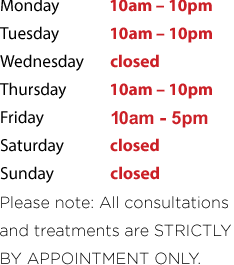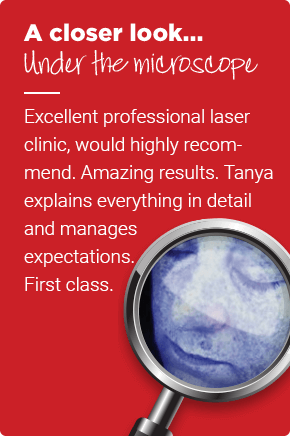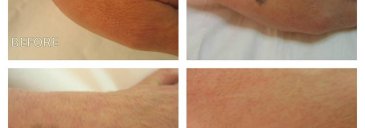Red Vein & Rosacea Treatment
Why come to Gresford Skin & Laser Clinic for red vein removal?
We understand the sensitivity of developing facial thread veins, Rosacea, Spider Naevi and Port Wine Stains. Our trained staff ensure that you are treated in a safe and suitable environment and we select our treatments and products carefully, only offering those that can deliver what they promise.
We listen to our clients, to understand their objectives and desires…
We comply with legal and professional standards. We comply with legal and voluntary regulations, we select products that have been appropriately licensed; we use appropriately qualified and skilled practitioners for each type of treatment.
What are Red Veins, Rosacea, Spider Naevi & Port Wine Stains?
Theses blemishes are all forms of vascular lesions which are abnormally large or broken blood vessels situated close to the surface of the skin, resulting in unwanted red pigmentation. Vascular lesions range from severe port wine birthmarks to relatively minor broken veins on the face or legs but sufferers at either end of the spectrum often experience low self-esteem either as a result of other people’s reactions to their condition or their own self-consciousness.
The most serious and potentially disfiguring vascular lesion is a port wine stain (PWS) which is made up of a complex network of blood vessels situated too close to the surface of the skin. Less serious are conditions such as telangectasia or rosacea, which are made up of dilated or broken blood vessels under the surface of the skin. Based on the theory of selective photothermolysis, the successful removal of all vascular lesions depends of the absorption of light by the blood cells.
Our basic treatment procedure:
Vascular lesion treatments are not painless and the skin is anaesthetised or cooled to minimise patient discomfort, particularly in the treatment of facial port wine stains.
The treated port wine stain will darken both during and after treatment as the skin is effectively being bruised. This will last for between one and two weeks or until new tissue replaces the treated tissue. The number of treatments required will depend very much on the depth, size and anatomical location of the lesion.
The treatment of individual veins in conditions such as telangectasia and rosacea will result in blanching and this should be taken as the treatment end-point. The number of treatments required will vary considerably depending on the nature of veins being treated.
VASCULAR LESION REMOVAL FACTS
Questions and Answers about Vascular Treatments
How does the system work?
The system consists of intense light that is emitted in a series of short pulses. The wavelength of the light is specially selected so that when it is directed into the skin, it is predominantly absorbed by blood vessels within the epidermis and dermis. In areas of vascular lesion, the blood vessels are overgrown or in high concentration. These blood vessels will absorb the light, which causes them to heat up and undergo a process called thermocoagulation. This destroys the entire vessel while causing minimal damage to the surrounding skin. Following treatment, the damaged vessels are absorbed by the body and little or no trace of the initial lesion remains.
How is the treatment carried out?
A thin layer of gel is applied to the skin prior to treatment which helps to cool the skin, as well as ensuring optimal transmission of light from the applicator to the skin. In addition, a cold air jet is applied during treatment to keep the skin as cool as possible.
A test patch is always taken; the rectangular quartz applicator is placed in contact with the skin surface over the offending blood vessels. The light is pulsed through the quartz and onto the skin. If the results of the test patch are satisfactory, the applicator is then moved to the neighbouring area and the process is repeated. During treatment the patient always wear protective eye goggles.
Blue veins are removed by using a 1064 Nd Yag Laser- this wavelength is absorbed by the “blue” de-oxygenated venous blood in the unwanted veins. The light absorption causes heating in the vessels and in turn thermo-coagulates the blood and blanching or darkening is seen, indicating effective treatment .
Treated blue veins are then broken down and absorbed and broken down by the body’s defence system. The number of treatments required will depend on the number of veins being treated, but it usually takes between 1 and 5 treatments, with a gap of 4 weeks separating each treatment.
Which patients can be treated?
The upper skin layer, the epidermis, contains melanin, a very good absorber of light, which is why it is the skin’s natural defence against harmful sunrays. The concentration of melanin in the skin is greater in darker skinned people and increases when the skin is exposed to UV light. The light emitted by the system will be absorbed to a certain extent by the melanin as well as the vascular regions and will heat the skin.
The more melanin in the skin, the more heat will be produced so it is therefore not possible to treat dark-skinned and tanned individuals. The lesions that will respond best are thought to be those consisting of blood vessels of a small diameter that lie close to the surface of the skin, such as those seen in rosacea or thread veins. If there are any areas of broken skin, the treatment should be delayed until the area has completely healed.
Does it hurt?
As the light energy is absorbed by the skin, it heats it up, and creates a sharp pinprick, burning sensation. Most patients describe the discomfort as moderate and acceptable. No anaesthesia is required.
What should I expect after the treatment?
Redness and a slight tingling and warm sensation are normal after treatment. A skin cooling device will be applied to the skin to ease these symptoms. You might notice that some vessels have disappeared immediately. Occasionally there may be some facial swelling-especially in the cheek area.
What are the side effects?
The visible light is completely safe so no special precautions are needed apart from glasses for the brightness. The skin of some patients becomes quite red immediately after treatment and in rare cases some bruising may be seen. However, most patients experience no side effects and the described skin reactions usually disappear within hours to a few days. Very rarely hyperpigmentation, hypopigmentation or blistering may occur.
How do I prepare for treatment?
Patients should avoid tanning and must not use any fake tan 4 weeks ahead of and during the entire treatment period to avoid excessive discomfort from light absorption in the epidermis. Immediately after the treatment, the skin is particularly sensitive to UV light, and strong sunlight should be avoided for 1-2 weeks.
How long does treatment take?
The length of each treatment will depend on the type and size of lesion present, but a typical session for rosacea will take in the region of 15 to 30 minutes.
How many treatments are necessary?
The length and number of treatments will depend on the type and size of lesion present, but typically 1-5 treatments will be needed. Treatments should take place approximately every 4 to 6 weeks.
Prices depend on the extent of vascularisation and the size of the area to be treated.
Please download Red Vein & Rosacea Treatment Brochure
Prices are available on request.
Book an appointment today. Call 01978 854411 or email: tanya@gresfordskincareclinic.co.uk




